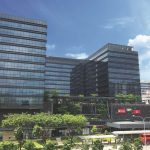CBRE’s research Singapore Real Estate Market Outlook 2021 says Singapore real estate market recovery will gain momentum in 2021
- Investment activity poised to rebound with the Singapore real estate market recovery
- A shift in working arrangements and shoppers’ behavior will continue with the Singapore real estate market recovery, to change the way space is being consumed

According to CBRE’s research, the Singapore real estate market recovery is expected this year, albeit uneven across sectors, as the city emerges from the pandemic-induced disruption of 2020.
The gradual Singapore real estate market recovery over the next 12 months is underpinned by a possibly extended low interest rate environment, as well as the government’s continuous efforts to reinforce its status as a regional trade hub.
Mr Desmond Sim, CBRE’s Head of Research, Southeast Asia, says, “With the pandemic contained locally and access to vaccination secured, brighter prospects are expected for the local economy towards the latter half of 2021, led by the service and construction sectors. Nonetheless, as the global COVID-19 situation remains volatile, recovery is likely to be bumpy and uneven.”
Mr Sim continues, “To facilitate Singapore’s economic recovery, the Monetary Authority of Singapore is likely to retain its accommodative policy stance in 2021, keeping interest rates low. The extended low interest rate environment will increase the attractiveness of commercial real estate in Singapore, especially those that can provide stable returns. What’s more, as Singapore continues to establish itself as an aviation and distribution hub, logistics demand is expected to remain healthy.”
Sectoral Highlights – Singapore Market Outlook 2021:
Reviewing Office Strategy
- 2021 is envisaged to be a year of two halves for the office market. While the first half is expected to still be under pressure, the latter half is likely to witness some improvement. The underlying strength of the office market is underpinned by healthy fundamentals and the diversified occupier profile seen today.
- Leasing demand in 2021 is expected to be led by the technology, finance and professional services sectors as there are high demand for their services.
- The continued demand for office spaces, coupled with limited Grade A supply in the pipeline, will support office rental growth in the second half of 2021. However, it will not be a uniform recovery in rents across all office buildings.
- Occupiers’ strong preference towards office buildings with efficient floor plates and are well-equipped with smart technology underscores the importance for landlords to accommodate the changing demand of occupiers. Landlords of buildings with emerging vacancy in the near term will need to be more flexible in rental incentives and negotiations.
- Remote working is expected to affect office demand but the physical office still remains relevant for firms to curate a social identity. De-densifying of office space based on current safe distancing may cushion the impact.
Investors to Realign Strategies
- While investors remain cautious, with ample liquidity in the currently low interest rate environment, they will be in search for investments that can provide them with higher returns, but now with stability and value also top of mind.
- Investors prefer asset types that have been less affected by the pandemic, such as office, industrial and residential; sectors which have been proven to provide dependable and durable income streams.
- Healthy demand for homes expected in 2021 would reduce unsold inventory, which could revive developers’ appetite for land, starting with smaller sites, and drive a nascent recovery for the residential collective sales market in 2021.
- Barring any unforeseen circumstances, CBRE forecasts that investment sales volume in 2021 is likely to rebound by 30% from S$11.299 billion recorded in 2020.
Continued Resilience in Logistics
- – The subdued upcoming warehouse supply will lend support to occupancy. Meanwhile, occupiers may be more inclined to plan for relocations or expansions ahead of time to secure their preferred options.
- With social distancing measures still in place, it is expected that third-party logistics and e-commerce segments to continue driving demand in 2021, while government stockpiling will continue to ease off.
- CBRE Research forecasts a 0.7% y-o-y growth for prime logistics rents in 2021. Stable rental growth is expected thereafter, at a similar pace of growth in both 2022 and 2023.
Reconnecting with Retailers
- The overall trend of portfolio rationalization is set to continue, leading to increasing space availability. This will cause both existing and new retailers to rethink their store locations, while reducing rental expenses across their portfolio. Savings incurred can be redirected into enhancing the quality of their key flagship stores.
- After falling by 8.6% y-o-y in 2020, average prime retail rents are expected to stabilize over the course of 2021. The sub-urban market will continue to be the most resilient, while the fringe and CBD locations are likely to see a slight recovery as footfall from the working population improves.
- With headwinds in the tourism sector to weigh on the near-term outlook of the sector, the rental gap between Orchard Road and the suburban market could narrow further.
- The two-tier market between prime and secondary retail spaces is expected to widen, although rental corrections and vacancies for the secondary locations and floors could present opportunities.
- Rather than focusing purely on rents, landlords and tenants should establish better synergies in the aspect of flexibility in lease negotiations and terms.
Residential to Resume Momentum
- Encouraged by 2020’s sales performance, developers are likely to capitalize on the sales momentum to clear remaining project inventory this year.
- The market continues to be driven by units at an affordable quantum. CBRE Research expects the quantum size for new sales transactions to continue to widen, as price sensitivity is likely to decrease with the aid of low interest rates.
- CBRE Research forecasts that the Private Residential Property Index will continue to edge up and may achieve a 0% to 2% growth in 2021.






